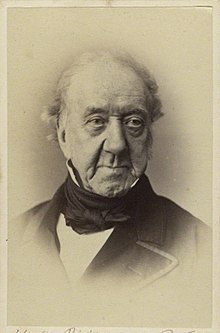
Summary
Henry William Pickersgill RA (3 December 1782 – 21 April 1875) was an English painter specialising in portraits. He was a Royal Academician for almost fifty years, and painted many of the most notable figures of his time.
Henry William Pickersgill | |
|---|---|
 William Pickersgill in the 1860s | |
| Born | 3 December 1782 London, England |
| Died | 21 April 1875 (aged 92) |
| Nationality | English |
| Education | École nationale supérieure des Beaux-Arts, Paris |
| Known for | Painter of portraits |
| Movement | Orientalist |
Biography edit
Born in London, Pickersgill was adopted in his youth by a Mr Hall, a silk manufacturer in Spitalfields,[1] who financed his schooling and then took him into the family business. When war caused difficult trading conditions, Pickersgill opted to develop his talent for painting into a career, and was a pupil of landscape artist George Arnald between 1802 and 1805 before entering the Royal Academy Schools as a student in November 1805.[2][3]
His early subjects were varied and included landscapes and classical and historical themes, but he eventually settled to portraiture as his speciality. His first exhibit at the Royal Academy was a portrait of his benefactor Mr Hall,[2] and during his lifetime he showed a total of 384 paintings there.[4] He was elected to associate membership of the Academy in November 1822 and full membership in February 1826.[3]
Pickersgill was one of the pre-eminent portrait painters of his day. Robert Peel, William Wordsworth, George Stephenson, Jeremy Bentham, Letitia Elizabeth Landon, Elizabeth Barrett Browning, Lord Nelson, the Duke of Wellington and Faraday were among the many notable people who sat for him. He famously painted author James Silk Buckingham and his wife Elizabeth in Arab costume in 1816, reflecting Buckingham's own travels in the East as well as the fashion of the times for the Orient. The National Portrait Gallery, London has over 50 of his portraits in its collection, including 16 original oils and 35 engravings after him,[5] along with a small number of portraits of Pickersgill himself by others.[6]
From 1856 to 1864, he was librarian of the Royal Academy.[3] He retired from the institution in December 1872, and died at his home in Blandford Square, London,[7] at the age of 93.[3] He is buried in Barnes Cemetery.
Pickersgill's brother Richard, son Henry Hall and nephew Frederick Richard were also painters. His wife Jeanette published a volume of poetry in 1827 entitled Tales of the Harem.[4] After her death in 1885, Mrs Pickersgill became the first person to be legally cremated in the United Kingdom at Woking Crematorium.[8]
In his will Pickersgill left a bequest to the Royal National Lifeboat Institution. The lifeboat Henry William Pickersgill R.A., which served on the Dover station between 1878 and 1888, was funded by this bequest.[9]
a poem by L. E. L.
Letitia Elizabeth Landon's poem The Oriental Nosegay by Pickersgill in her Poetical Sketches of Modern Pictures (in The Troubadour, 1826) probably refers to his Oriental Love Letter (1824) in the R. A. collection.[10]
Gallery edit
-
Alexander Ball, c. 1806
-
Matthew Gregory Lewis, 1809
-
Daniel Terry, 1813
-
George Crabbe, 1818
-
Hannah More, 1821
-
George Murray, 1825
-
Sir Jacoby Astley, 1826
-
Lady Astley, 1826
-
Michael Faraday, 1826
-
John Poole, 1827
-
Jeremy Bentham, 1829
-
William Godwin, 1830
-
Alexander von Humboldt, 1831
-
Edward Bulwer-Lytton, 1831
-
Viscount Hill, c.1835
-
Thomas Drummond, c.1835
-
Charlotte Mardyn, 1836
-
Edward Brace, 1837
-
John Conroy, 1837
-
Edward Denison, 1838
-
Thomas Turton, 1844
-
Richard Owen, 1845
-
Robert Vernon, 1846
-
Henry Benjamin Hanbury Beaufoy, 1848
-
Edward Owen, c.1849
-
Emily Maria Pickersgill, 1850
-
William Wordsworth, 1850
-
William Gordon, 1854
-
Charles Barry, Unknown date
-
Robert Peel, Unknown date
See also edit
References edit
- ^ F. H. W. Sheppard (1957). "The Wood-Michell estate: Hanbury Street west of Brick Lane". Survey of London: volume 27: Spitalfields and Mile End New Town. Institute of Historical Research. Retrieved 13 August 2013.
- ^ a b Lee, Sidney, ed. (1896). . Dictionary of National Biography. Vol. 45. London: Smith, Elder & Co.
- ^ a b c d "Royal Academy of Arts – Henry William Pickersgill, RA". Retrieved 28 January 2009.
- ^ a b "Object of the Month: Henry William Pickersgill RA (1782–1875), The Oriental Love Letter". Royal Academy website. July 2008. Retrieved 29 January 2009.
- ^ "Portraits by Henry William Pickersgill at the National Portrait gallery, London". Retrieved 30 September 2008.
- ^ "Portraits of Pickersgill at the National Portrait Gallery in London". Retrieved 30 September 2008.
- ^ "Wills and Bequests". Illustrated London News. 5 June 1875. Retrieved 28 January 2009.
- ^ "How cremation became the way to go". BBC News Online. 25 March 2009. Retrieved 25 March 2009.
- ^ "Previous Dover Lifeboats". Dover Lifeboat website. Archived from the original on 24 March 2007. Retrieved 30 September 2008.
- ^ Landon, Letitia Elizabeth (1827). "The Oriental Nosegay". The Troubadour, 1825. Longman, Rees, Orme, Brown and Green. p. 273.
External links edit
- 127 artworks by or after Henry William Pickersgill at the Art UK site
- The Minstrel of Chamouni. is a painting of 1828, based on an earlier portrait of Letitia Elizabeth Landon. This engraving was the frontispiece to The Amulet annual for 1830.
- The Greek Girl., engraved by Charles Fox for The Amulet annual for 1832, with a poetical illustration by Letitia Elizabeth Landon.
- Picture in oil colours by George Baxter of Zenobia. in Pictorial Album; or, Cabinet of Paintings, 1837, with a poetical illustration by Letitia Elizabeth Landon


